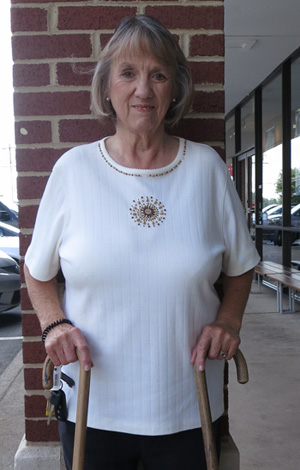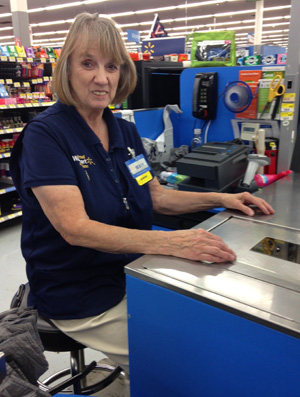When Mary Nay turned 70, she celebrated by walking a mile at her gym. The next year, she turned 71 and walked two and a half miles.
Her commitment to fitness would be impressive no matter what, but Mary has cerebral palsy and walks with two canes. She has muscular issues in her legs, hips and knees that make walking challenging. She also has trouble hearing.

But besides exercise, she fills her days working at Walmart, spending time with her husband, children and grandchildren, and promoting the book she wrote last spring, “Hardly Handicapped: Walking Through Life with Cerebral Palsy.”
“She could come up with a whole list of excuses if she tried,” says Bentley Calhoun, MD, who sees Mary at UVA’s primary care clinic at Forest Lakes and walked the last lap with her on her 71st birthday. “But unlike most, she has managed to turn excuses into motivation.”
A Cerebral Palsy Diagnosis
Mary’s parents first realized something was off when she didn’t sit up or crawl. The family lived in Farmville, and taking Mary to the doctor meant driving to Richmond or a specialist in Maryland. It took many doctors’ visits to get a diagnosis of cerebral palsy, which meant her muscles didn’t communicate well with her brain.
Eventually Mary started walking. Doctors put her legs in braces and assigned her exercises to build the muscles in her legs and discourage her from walking on tiptoe.
Mary mostly stayed at home with her parents and older sister. She wore the braces until age four or five, but even after they came off, she was well aware that she couldn’t run or play hopscotch like the other girls could.
Starting school was scary. “I walked in the door, and I saw all these kids looking at me,” she recalls. “I didn’t like that, and I didn’t know how to deal with it, because I had never been in public that much. So I cried and cried and cried and didn’t want my mom to leave. The teacher let my mom stay one week, but finally I had to let go.”
After that rough week, Mary flourished. She became good friends with a pair of twins, Joan and Martha. She couldn’t play sports, so she kept the score. In high school, she was allowed more time than most students to change classes, due to what she calls her “clumsy walk.”
Mary recalls she felt bad when she noticed her classmates were starting to date and nobody asked her out. “I knew: ‘Forget it Mary, that’s not going to happen.’” But that changed too — she dated one boy in 11th grade and attended senior prom with another.
That same year, her classmates announced they wouldn’t go on their senior class trip to New York City if Mary couldn’t go. The school’s sports coach came along and helped her get around, and she got to go to the top of the Empire State Building.
Finally, at graduation, Mary’s parents wanted to walk across the stage with her. The girl who had clung to her mom on her first day of school was horrified by that idea. “I said, ‘If you don’t let me walk by myself, I’m not graduating.’” So she walked alone.
Declining Mobility
After graduation, Mary attended Woodrow Wilson Rehabilitation Center, which provides vocational training for people with disabilities. She then moved to Charlottesville, 60 miles from her hometown, to look for a job. She ended up at Comdial, a telecommunications company, where she worked in many departments for over 31 years. She also had a part-time job for 23 years at political polling firm Cooper & Secrest, where she eventually became a supervisor.
At Comdial, Mary’s mobility began deteriorating. Early in her career there, she struggled to quickly walk down the long hallways, so she got a mobility scooter to help her. But “my mobility went down fast and big time,” she says. She became overdependent on it, and her leg muscles weakened, until she had trouble walking and keeping her balance.
“Today, I wish that I could not have used the scooter, but the past is in the past,” she says.
Calhoun, Mary’s longtime physician, felt she could do better. In 2011, after almost 30 years of scooter overdependence, he referred her to an exercise rehabilitation program through a nearby gym. She began using exercise machines to strengthen the muscles in her legs, and the gym became her second home. “My whole energy level changed,” she says.
Between Dr. Calhoun’s support and care and the exercise program, things started to turn around for Mary. When she drove, she used to use her hand to lift her leg back and forth between the gas and break pedals. As she exercised, she discovered she could move it without the help of her hand.
And finally, she began walking longer distances again, which led to walking a mile around the gym’s track on her 70th birthday.

“As her level of health improved, so did her audience,” Calhoun says. “Mary Nay, who has spent much of her adult life relying on assistance for mobility, was walking. And not just walking, but walking an entire mile around the track. You should have seen it. It was like a little mini circus there at the club. Family members, club members, health care providers and curious onlookers all cheering for Mary as she crossed the finish line.”
Mary, in turn, credits Calhoun with referring her to the program and advocating for her so work and life are easier. After retiring from Comdial and Cooper & Secrest, she got a job at Walmart. Calhoun advocated for her, telling her managers she couldn’t lift much weight and needed a stool to sit on. “I would recommend him to the top of the mountain,” she says. “He is not only my doctor but my friend.”
Writing “Hardly Handicapped”
Mary’s book and reputation at her gym have turned her into a local celebrity. She was featured in The Daily Progress, and she’s had multiple book signings. At one, she had a reunion with her old friend and doctor, Peyton Taylor, MD, who she hadn’t seen in years.
“In June 2014, when The Daily Progress wrote a great story about me, he saw it and called to say he was proud of me,” she says. “Then, to my surprise, he came to my book signing. We had such a great reunion.”
Mary started writing because she hopes to inspire others with disabilities. “I hold no grudges that I am born handicapped,” she says. “I do believe God made me this way for public awareness, so people could see what you have to do to have a life. And you can have a life. I’ve got one. I’m married, I have three daughters, a job, I’ve done it.”
It’s been hard. People have made comments, but you have to decide what you want to do, whether you want to accept it or let it tear you down. And I chose to put a smile on my face and go for the gold.”
Where to find the book: Mary’s book is available at Barnes & Noble in Charlottesville. You can also purchase her book through Tate Publishing.
Mary,
You are an inspiration to us all! Thank you for sharing your story.
What a remarkable story and remarkable woman.
Mary,
You are one of the most inspiring people I’ve ever met. You have been a wonderful addition to the Walmart 1780 team and you are a terrific cashier and a *WONDERFUL* woman!
Mary,
My admiration and respect! You are a very special lady.
Mary and I met due to our love for country music and our favorite singer, Tommy Wood from Ruckersville! She is a remarkable woman whom I’m proud to call my friend. Amazing spirit and one we should all use as a role model. When you start feeling sorry for yourself, just think, what would Mary do and you’ll put on a smile and move forward. Great inspiration!
Mary,
Thank you for sharing your story, you and your book are inspiring. It has been such a privilege getting to know you and seeing the success of your book!
Mary is a totally remarkable woman. You have to admire her determination and strength!
Thanks for the inspirational Story. My Son has CP and I’ve looking for a starting point. This is it for me. Keep Walking my dear. And we will start Praying and working towards our goal.